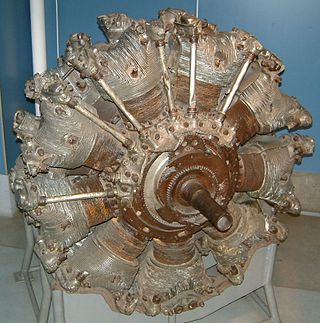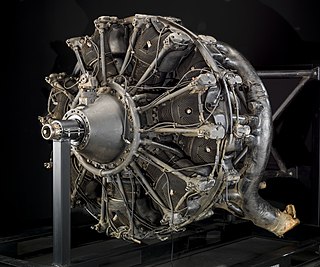
The Kyūshū J7W Shinden was a World War II Japanese propeller-driven prototype fighter with wings at the rear of the fuselage, a nose-mounted canard, and pusher engine.

The Mitsubishi A7MReppū was designed as the successor to the Imperial Japanese Navy's A6M Zero, with development beginning in 1942. Performance objectives were to achieve superior speed, climb, diving, and armament over the Zero, as well as better maneuverability – all parameters that were ultimately achieved towards the end of its development in 1945. However, limitations on Japanese industry towards the end of the war prevented the A7M from ever entering mass production or being deployed for active duty, and it never saw active service. Its allied reporting name was "Sam".

The Nakajima Ki-44 Shoki was a single-seat fighter-interceptor which was developed by the Nakajima Aircraft Company and operated by the Imperial Japanese Army from 1942 to 1945 during World War II. Its official designation was Army Type 2 Single-Seat Fighter (二式単座戦闘機) and its Allied reporting name was Tojo.

The Nakajima Ki-84 Hayate is a single-seat fighter flown by the Imperial Japanese Army Air Service in the last two years of World War II. The Allied reporting name was "Frank"; the Japanese Army designation was Army Type 4 Fighter. The Ki-84 is generally considered the best Japanese fighter to operate in large numbers during the conflict. The aircraft boasted high speed and excellent maneuverability with an armament that gave it formidable firepower. The Ki-84's performance matched that of any single-engine Allied fighter it faced, and its operational ceiling enabled it to intercept high-flying B-29 Superfortress bombers. Pilots and crews in the field learned to take care with the plane's high-maintenance Nakajima Homare engine and landing gear prone to buckling. The difficulties of Japan's situation late in the war took a toll on the aircraft's field performance as manufacturing defects multiplied, good quality fuel proved difficult to procure, and experienced pilots grew scarce. Nevertheless, a well-maintained Ki-84 was Japan's fastest fighter. A total of 3,514 aircraft were built.

The Nakajima Homare was an air-cooled twin-row 18 cylinder radial Japanese aircraft engine manufactured during World War II. Producing almost 2,000 horsepower, it was used widely by both the Imperial Japanese Army and the Imperial Japanese Navy. Given the Navy service designation NK9, the "Homare" was also given the company designation NBA, Army experimental designation Ha-45 (ハ45) or, Army long designation Nakajima Army Type 4 1,900 hp Air-Cooled Radial and, (coincidentally) unified designation code of Ha-45.

The Mitsubishi Kasei was a two-row, 14-cylinder air-cooled radial engine built by Mitsubishi Heavy Industries and used in a variety of World War II Japanese aircraft, such as Mitsubishi J2M and Mitsubishi G4M. The Mitsubishi model designation for this engine was A10 while it was an experimental project, in service it was known as the MK4, and known as the Ha101 & Ha111 by the Army and Kasei by the Navy. According to unified designation code it was Ha-32 of the variants from 11 to 27.

The Nakajima Sakae was a two-row, 14-cylinder air-cooled radial engine used in a number of combat aircraft of the Imperial Japanese Navy and Imperial Japanese Army before and during World War II.

The Nakajima Ki-49Donryu was a twin-engine Japanese World War II heavy bomber. It was designed to carry out daylight bombing missions, without the protection of escort fighters. Consequently, while its official designation, Army Type 100 Heavy Bomber, was accurate in regard to its formidable defensive armament and armor, these features restricted the Ki-49 to payloads comparable to those of lighter medium bombers – the initial production variant could carry only 1,000 kg (2,200 lb) of bombs.

The Mitsubishi Ki-30 was a Japanese light bomber of World War II. It was a single-engine, mid-wing, cantilever monoplane of stressed-skin construction with a fixed tailwheel undercarriage and a long transparent cockpit canopy. The type had significance in being the first Japanese aircraft to be powered by a modern two-row radial engine. During the war, it was known by the Allies by the name Ann.
The Nakajima Ha1 Kotobuki was an aero-engine developed by Nakajima. It was a radial piston developed under licence from the Bristol Jupiter.
The Mitsubishi Kinsei was a 14-cylinder, air-cooled, twin-row radial aircraft engine developed by Mitsubishi Heavy Industries in Japan in 1934 for the Imperial Japanese Navy. The Mitsubishi model designation for this engine was A8 while it was an experimental project; in service, it was known as the MK8 "Kinsei" by the Navy. In 1941 the engine was adopted by Army, receiving designation Ha-112. In May 1943 it received Ha-33 unified designation code.

The Aichi AE1A Atsuta was a Japanese licensed version of the German Daimler-Benz DB 601A 12-cylinder liquid-cooled inverted-vee aircraft engine. The Atsuta powered only two models of Imperial Japanese Navy Air Service (IJNAS) aircraft in World War II. The Imperial Japanese Army Air Service (IJAAS) used the same engine to power its Kawasaki Ki-61 Hien fighter. The IJNAS's Atsuta and its IJAAS cousin, the Ha-40 were based on the engine that powered Germany's Messerschmitt Bf 109E fighter.

The Mitsubishi K3M was a trainer built by Mitsubishi which was used by the Imperial Japanese Navy in an extremely wide variety of roles, including light transport, liaison aircraft, utility aircraft and occasionally light bomber. Its Allied reporting name was Pine.
The Nakajima Ha5 is a twin row, 14 cylinder air-cooled radial aircraft engine built by the Japanese Nakajima Aircraft Company. The engine was a development of earlier single-row Japanese engines, the Kotobuki and Hikari, which had combined features of the Bristol Jupiter and Pratt & Whitney R-1340 Wasp designs.

The Nakajima Mamoru engine was a 14-cylinder, air-cooled, two-row radial engine of 1870 hp. At some 44.9 litres displacement, it was one of the largest-displacement 14-cylinder radial engines in the world, rivalling the similar configuration Allies' American Wright Twin Cyclone engine of 42.7 litre and Soviet Shvetsov ASh-82 engine of 41.2 litre displacement levels, and was meant to compete with early 18-cyl engines. The Nakajima model designation for this engine was NAK while it was an experimental project, in service it was known as the NK7, and known as the Ha-103 by the Army and "Mamori" or "Mamoru" by the Navy. According to unified designation code it was Ha-36. The meanings of these two Japanese words are very similar, Mamori translates as protection and Mamoru, translates as to guard, protect, defend and obey.
The Mitsubishi Shinten was a two-row, 14-cylinder air-cooled radial engine built by the Mitsubishi Aircraft Company for the Imperial Japanese Army Air Service (IJAAS) and the Imperial Japanese Navy Air Service (IJNAS) in the early 1930s. Like many aircraft engines in Japan, there were multiple designations for this engine. The company model designation was A6(7) while it was an experimental engine project. Once accepted, it was known as the "Shinten" or MK1 by the IJNAS, and Ha6 by the IJAAS.
The Mitsubishi Zuisei was a 14-cylinder, supercharged, air-cooled, two-row radial engine used in a variety of early World War II Japanese aircraft. It was one of the smallest 14-cyl. engines in the world and the smallest diameter Japanese engine. The Mitsubishi model designation for this engine was A14 while it was an experimental project, in service it was known as the MK2, followed by the revision code letter, and known as the Ha26 & Ha102 by the Army and "Zuisei" by the Navy. Unified designation code was [Ha-31].
Japanese aero-engines for military aircraft were given a wide variety of designations depending on the customer. This led to much confusion, particularly among the Allied forces, where a single engine type could have up to six different designations. This situation emerged because of the almost total lack of co-operation in weapons procurement between the IJAAS and the IJNAS.
The Nakajima Ha219,, was a late war Imperial Japanese Army Air Force (IJAAF) 2,461 hp (1,835 kW) 18-cylinder air-cooled radial engine, used on the Tachikawa Ki-94-II, Nakajima Ki-84-N and Nakajima Ki-87.
The Hitachi Ha-51, was a Japanese air-cooled twenty-two-cylinder twin-row radial aircraft engine designed by Hitachi during the final years of World War II. The first prototype ran in 1944 at a rating of 1,772 kW (2,000 hp), but only four examples were built. In August 1945, development was halted. The engine had yet to find an application and bombing had destroyed the factory where production was to take place.











